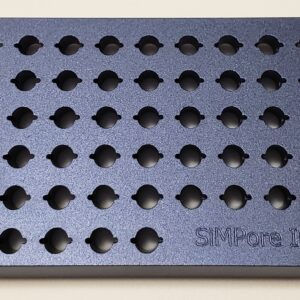Life Sciences
Nanofiltration Membrane Products
Nanofiltration membrane products for DIY microfluidic research.
SiMPore’s silicon nanomembranes are useful for filtering a range of solutes of varying sizes, from nanoparticles to mammalian cells, and come in several convenient formats.

Use our 25 mm silicone gaskets and any choice of our porous membrane chips to set up your own vacuum filtration with desired filtration cut-off.
Microfluidic Cell Culture
Our nanoporous, microporous, and microslit membrane chips are available in a number of cut-off pore sizes and are well-suited for microfabricated microfluidics and OEM applications.
DIY Microfluidic Cell Culture System
Our nanomembranes are available as stand-alone packs for building your DIY microfluidics system. Easily integrate them into fluidic devices to meet your specific applications.
- Create apical and basal chambers in standard tissue culture plates
- Culture single and/or multiple cell types on the highest permeable nanomembranes to image cells with exceptional optical clarity
- Create flow cells for separately addressable chambers, culture and introduce cells, and then image with exceptional optical clarity
Nanoporous membranes:
- Highest permeability and optical clarity with 50 nm pores
- Can also be used for filtration-based capture of nanoparticles or creation of nanoemulsions, or similar applications
Microporous membranes:
- Ideally suited for assay applications where micron-level cut-offs are needed, including separation of bacteria, cells, and similarly sized particles
Microslit membranes:
- Available in a range of micron-level cut-offs for more demanding Microfluidics separation applications, such as particle isolation, post-conjugation clean up, and analytical interrogations
Our Membrane Configurations
Through a range of proprietary and industry-standard methods, we’re able to offer various membrane configurations to meet your unique needs, whether that be nanoparticle separation or cell-based assays.
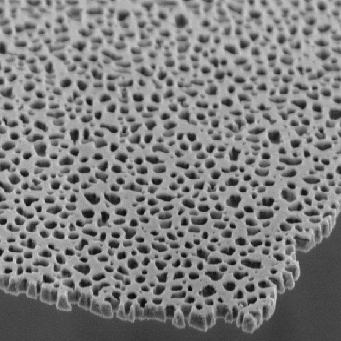
Nanoporous Silicon Nitride (NPN)
Unmatched capabilities
SiMPore’s innovative nanoporous silicon nitride (NPN) provides unparalleled permeability, optical transparency, and precision pore sizes – all in the same membrane material.
Patented manufacturing
Through a patented manufacturing process, nanopores are randomly created within a Silicon Nitride (SiN) layer of nanometer thickness; this process produces a very high pore density and thus highly permeable membranes.
Reduces inefficiencies
These NPN membranes are atomically flat and chemically inert, enabling markedly reduced biofouling and nonspecific interactions across a wide array of sample types.
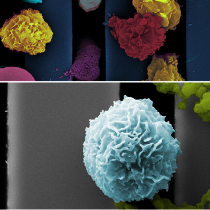
Microporous & Microslit Silicon Nitride (SiN)
Uniform design
SiMPore fabricates microporous and microslit membranes within low-stress silicon nitride layers deposited on prime-grade silicon wafers. These porous features are uniformly, photolithographically patterned and etched.
Resilient thickness
Current products offer 10-20% porosity in a robust 400 nm thick membrane for demanding flow-based applications.
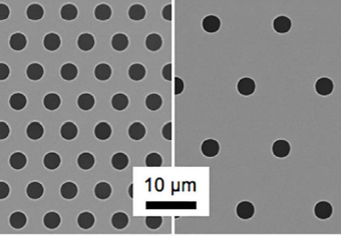
Microporous G-FLAT® Silicon Dioxide
Proprietary wrinkle-free substrate
Our microporous G-FLAT™ silicon oxide membranes are manufactured with a patented method, yielding a flat, porous, and glass-like layer. Current silicon nanomembranes are available with 5-20% porosity in a 300 nm thick membrane that is optically transparent.
Directly patterned
These membranes are directly patterned using photolithography, resulting in uniform pore sizes.
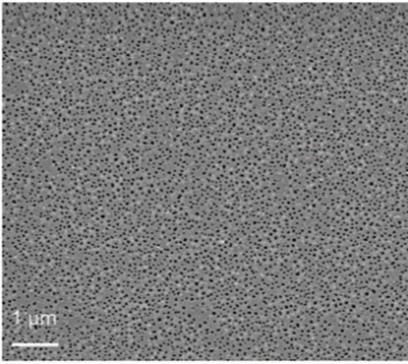
Custom Porous Membrane Chip Formats
Thickly framed
Currently available Membrane Chips feature a 5.4×5.4 mm, 310 µm thick silicon frame.
Custom specifications
Specific formats and related dimensions for various membrane thicknesses and membrane surface area per chip are listed below. The number of membranes per chip, as well as the membrane thickness (t), will vary depending on membrane product type.
Membrane Configuration Options
Membrane Window Format (Dimensions in um) |
||||||||
| Dimension Type | ID | 1 Slot | 2 Slot | 3 Slot | 4 Slot | 5 Slot | 1 Square | |
| Frame Thickness | D | 310 | 310 | 310 | 310 | 310 | 310 | 310 |
| Window Width | W1 | 700 | 700 | 700 | 300 | 150 | 1000 | 2000 |
| Membrane Window Length | L | 2000 | 2500 | 3000 | 3000 | 3000 | 1000 | 2000 |
| Frame Window Width | W2 | 1138 | 1138 | 1138 | 738 | 538 | 1438 | 2438 |
| Edge Margin (Sides) | 2300 | 1625 | 1100 | 1100 | 1500 | 2200 | 1700 | |
| Window Gap | d2 | – | 750 | 500 | 625 | 450 | – | – |
| Membrane Surface Area | A | 1.4mm2 | 3.5mm2 | 6.3mm2 | 3.6mm2 | 1.5mm2 | 1.0mm2 | 2.0mm2 |
| Example Applications | – | Cell Culture, Flow Cells, Microfluids | Dead-End Filtration, Microfluids | Cell Culture | ||||


